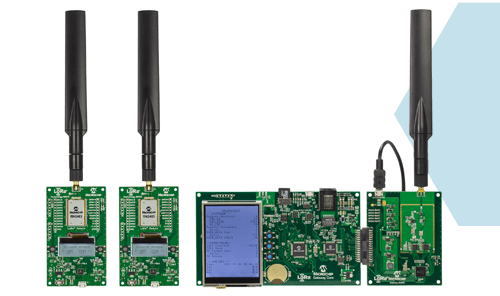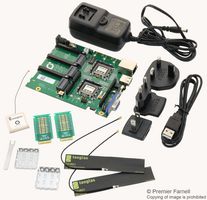Trends in Cellular IoT Part 2
LPWAN Challenges Cellular for Dominance as the Preferred IoT Wireless Technology
The new cellular standard for machine type communication (LTE-MTC or LTE-M) is an attempt to position cellular technology as the wireless technology of choice for the billions of devices predicted to make up the global IoT market. While the new standard adapts cellular technology for the Internet of Things, it isn’t the only technology hoping to build a dedicated following in the IoT space. Low-power wide area network (LPWAN) technology has emerged as a formidable competitor for cellular. This article will discuss the competing technologies.
What is LPWAN?
LPWAN technologies are wireless wide area networks that enable connectivity at low-throughput (narrowband) over very long distances with ultra low power consumption. LPWAN technology is not new. It’s been used in machine-to-machine (M2M) communication networks for many years. The new attention being given to LPWAN is due to the need for low-cost, long-range, low throughput devices to support IoT solutions.
LPWAN has three main features that make it very good fit for IoT. It has a range of 5 to 40 km and the end nodes can be a long distance from the gateway, up to 10 km. LPWAN has ultra low power consumption so batteries that power remote sensor nodes can last for up to 10 years. Finally, LPWAN is ideal for the low throughput requirements of IoT data packets, usually transmitted at no more than a couple of hundred bits per second (bps).
Both cellular and LPWAN technologies have been deployed in legacy M2M networks such as utility metering, gas detection, smart grid, agriculture, and asset tracking. But in situations where cellular has been too expensive, LPWAN technology is considered a natural alternative. But this was prior to the introduction of the new cellular LTE-M standard.
Wireless IoT Technologies | ||
Short Range | Long Range | |
| Cellular
| LPWAN
|
LPWAN vs. Cellular
Given the inherent benefits of LPWAN, will it replace cellular as the dominant wireless technology for the IoT market? The future outcome will likely be determined by the choices IoT engineers make when designing systems. However, the cellular industry has responded to LPWAN’s support by delineating the benefits of cellular as a wireless connectivity technology, especially with respect to the new LTE-M standard.
The new cellular standards – LTE-M, LTE Cat-0, 1, M1, NB1, NB-LTE – enable cellular to provide a low-power, low throughput, wireless technology required by IoT solutions. One useful advantage is that to implement the new standard, cellular operators would only need to upgrade their network software, without needing new antennas, providing potential cost savings. Of course, whether these cost savings will be passed onto IoT customers will be determined in the future.
Another factor that favors cellular technology’s adoption in IoT is that cellular has been used with M2M applications (e.g., asset tracking, utility metering, etc.) for decades all over the world. Migrating millions of M2M devices from cellular to LPWAN would be a huge expense in labor and time. Furthermore, LPWAN providers would need to build out their networks while cellular operators already have their networks in place.
The final factor is time. Customer demand may accelerate or delay the cellular industry’s implementation of low-cost LTE-MTC devices. If it were to take too long, the door may open much wider for LPWAN network providers who are ready right now.
LPWAN Technologies
There are numerous LPWAN technologies emerging as alternatives to cellular for the IoT market. Three of the most popular LPWAN technologies are:
- Sigfox
- Weightless-N
- LoRaWAN
Sigfox provides a cellular-like, scalable, high-capacity network with very low power consumption. It uses Ultra Narrow Band (UNB) technology to connect remote devices for low-power, low data rate applications. Sigfox can communicate with millions of nodes across cells of several square kilometers, making it suitable for various M2M applications such as smart meters, patient monitors, security devices, street lighting and environmental sensors. It operates in the unlicensed ISM radio bands: 868MHz (Europe) and 915MHz (US). It has a range of 3 to 10 km in urban areas and up to 50 km in rural areas. It requires fewer antennas compared to traditional cellular networks such as GSM/CDMA. It has a data rate of 100 bps and a packet size of only 96 bits. Batteries can last over 10 years and in some cases up to 20 years.
Weightless-N is an open wireless technology standard that’s used for transmitting data between a base station and thousands of devices. The name “Weightless” relates to the lightweight nature of the protocol since its overhead per transmission is minimized for devices that transfer only a few bytes of data. It operates in sub-GHz spectrum using ultra narrow band (UNB) technology. It has a data rate of 100 bps and a range of five kilometers in urban environments. It has very low power consumption, providing for long battery life. Weightless-N is well suited for transmitting temperature data, tank level monitoring, and metering data.
LoRaWAN Network Evaluation Kit by Microchip

LoRaWAN is an LPWAN standard tailored to wireless battery operated devices for regional, national or global networks. It offers secure bi-directional communication, mobility, and localization services for smart city and industrial applications. It provides seamless interoperability among embedded devices without the need of complex local installations. It’s optimized for low-power consumption and supporting large networks with millions and millions of devices with data rates ranging from 0.3 kbps to 50 kbps. It’s also capable of operating on energy harvesting technologies.
The Deciding Factor: Availability of LTE-MTC Cellular Devices
At the time of writing this article, 3GPP has recently completed the standardization of LTE-MTC (Cat-M1) and NB-IoT devices. But this is only the first step of introducing this new generation of LTE Advanced devices to the marketplace. Now begins the work of commercializing these new cellular-based technologies for IoT hardware. This circumstance poses a challenge for the cellular industry. The mass market adoption of LTE devices based on the new LTE-MTC standard is up against SigFox, Ingenu, and LoRa Alliance members who are already deploying networks with LPWAN technologies. The availability of LTE-MTC devices may very well be the deciding factor in the battle for long-range, wide-area, wireless IoT technology dominance.
Where do you think the Cellular vs LPWAN competition is headed? Will LPWAN become the preferred long-range, wide-area, IoT technology? Or, will the changes implemented in the new LTE-MTC standard make cellular the technology of choice for IoT engineers? What do you think of the prospects of cellular-based IoT? Will it grow in popularity in the next decade, or like some folks say, “cellular is not IoT.” Share your thoughts here.
In the third and final article in this series on the trends in cellular-based IoT, we will discuss “clean slate” NB-IoT technology, a new non-LTE, narrowband technology proposed by 3GPP that will provide improved indoor coverage, ultra-low device cost, low device power consumption and support of massive number of low throughput devices. NB-IoT is considered the overall most promising cellular technology for IoT.

Chicago Smart City Project Uses Cellular Connectivity
Chicago’s Smart City IoT project, called the Array of Things (AoT), will collect real-time, location-based data about the city’s environment, infrastructure, and activity to both researchers and the public. Five hundred AoT nodes will be secured to street light poles in select locations around the city. The current AoT node architecture consists of a sensor module and an open source resilient support network. No data will be stored in the nodes. Once the data is collected, it will be transmitted via cellular connectivity to an open source database.
Featured Product
Powered by an ARM-based application processor, the Sierra Wireless MangOH Green is a cellular modem with wireless processors (2G to 4G & LTE-M) and an application processor running Legato, an open source embedded platform built on Linux for hosting IoT applications.
Learn More
